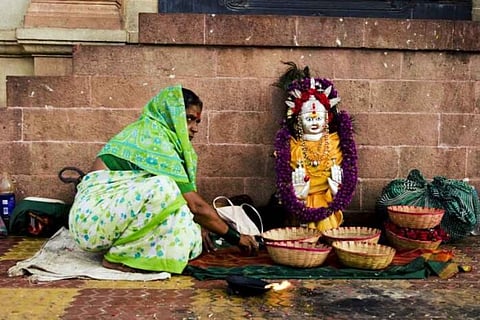
Believed to have started in the sixth century, Devdasi tradition is a testament to the exploitation of women. Devdasis used to dance after marrying the "Deity". References also point out to the status of high-stature women being given.
Women are still falling victim to the long-held tradition of Devdasi, which we all are aware of. It has been accorded religious status and is conducted on a large scale. The Mooknayak has combed through the history of this tradition …..
The History
Many rituals and traditions have existed since the Vedic era of the Indian Civilization. One such tradition is the culture of "Devdasi" although, it is deplorable by the normative horizons of current Indian Society, it has nevertheless persisted through centuries.
Historians point out that it possibly started in the 6th century CE. Most of the Puranas are also believed to be written in this era. The practice is more prevalent in the temples of South India. Devdasi means "Servant of God".
On the condition of anonymity, a professor of Sociology at Barkatullah University told The Mooknayak that "This practice of Devdasi can be traced back to the pre-Aryan era. According to historians the primary aim behind this ritual was religious. Devadasisacted as custodians of dance, music and religion. In the 11th Century, Rajeswar of Tanjore is said to have harboured 400 Devdasis. Somnath Temple had 500 Devdasis. It prevailed in Tirupati and najagud until 1930.
Devdasis were dedicated to worship and were entrusted with serving one "diety". There is a ceremony which marks their induction, which is to some extent similar to the wedding ceremony. Apart from looking after the temple and conducting the rituals, these women also learnt the art forms like Bharatnatyam, Mohiniattam, Kuchipudi and Odyssey and practised them. They were accorded high social status because Dance and Music were an integral part of the temples.
Two categories of Devdasis
According to historians, Devdasis are of two types. The first is Rangabhoga and the second is Angabhoga. The second category of Devdasis do not step out of the temples. The ceremony of devoting to Yelamma Devi was akin to the wedding ceremony. The girl was aged between 5 and 10. A nude procession of the girl was brought to the temple. She was subsequently ordained as a priest. After the ceremony, the devadasis became the property of the temple and the priest. The priest of the temple used to allot the work accordingly.
Apart from the usual chores related to the temples, they were also required to provide sexual services to influential people like priests, officers, feudalists etc. However, their status was not relegated to that of prostitutes.
The practice exists to date.
This deplorable practice is still prevalent in Sholapur, Sangli, Usmanabad, Kohlapur, in Maharashtra and Belgaum, Bijapur, Gulbarga in Karnataka. Yellama Devi temple of belgam in Karnataka ceremonises devdasis every year on Magh Purnima. Local news mention this fact.
Meghdootam also has references to the Devdasi practice
Kalidas authored meghdootam mentions some lifelong unmarried girls who used to dance in the temples and are inferred as Devdasis. Eminent writer Dubois mentions in his book "Hindu manners customs and ceremonies" that every devadasi had to dance and sing in the temple. Also, she had to sleep with the guests coming to the temple. She was given food grains and some money in return. Dubois mentions that this practice is prevalent as a religious and traditional ritual for centuries.
The social condition of Devadasis in the past
According to historians, in the initial days of this practice, there was no stigma attached to Devdasis or their children and people of their caste treated them equally. A child of Devdasi was a legitimate child, although they were not given the name of the father.
Additionally, she was not restrained by the tag of widowhood and was considered auspicious as she was married to a "diety". Meaning that she has devoted her life to god. According to historians, the presence of devadasis in the homes of Upper caste was considered auspicious and she was given the due respect and gifts.
Historical books that have references to Devdasi culture.
| Books | Authors |
| Bhartiya Vivaha Sanstha ka itihas (History of India marriage institutions) | Vishwanath Kashinath Rajwage (Historian) |
| Slavery in Ancient India | Devraj Chanana |
| History of prostitution in India | S.N. Sinha and N.K. Basu |
| Wives of the King God: Rituals of Devdasis | Frederique ApffelMarglin |
| Studies in the cult of Mother Goddess in Ancient India. | Motichandra |
| History of Devdasi System | B.D. Satsokar |
| The Golden Bow | James. J. Frazer |
यहाँ हिन्दी में भी पढ़ें– जानें सदियों से चली आ रही 'देवदासी' कुप्रथा का इतिहास, महिलाओं के शोषण का जीता-जागता प्रमाण
Story Translated by Pratikshit Singh
You can also join our WhatsApp group to get premium and selected news of The Mooknayak on WhatsApp. Click here to join the WhatsApp group.